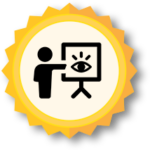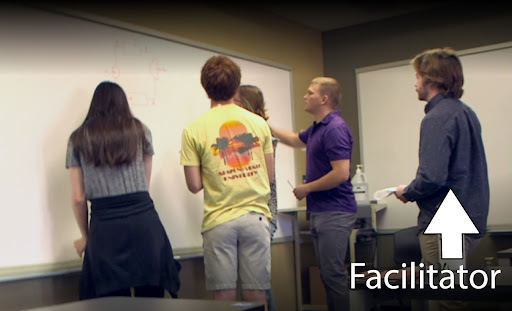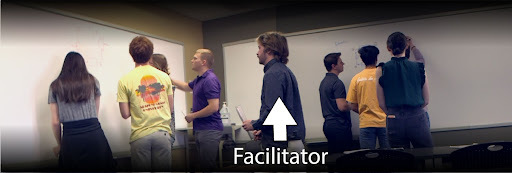Peer-Led Study Groups
 Overview and Introduction: The WHAT and WHO
Overview and Introduction: The WHAT and WHO
Peer-led study groups (PLSG) are a method of instruction in which peers of similar ability engage in dialogue to solve complex course-related problems. The process acquaints students with discipline-based problem solving in order to understand the subject as experts do, thereby increasing achievement, self-efficacy, and persistence in the major.
The PLSG model described here is based on work pioneered by Uri Treisman at the University of California at Berkeley in the 1970s, after he observed students’ study habits in his undergraduate calculus courses [1]. Treisman noticed that African American students were disproportionately low performing, especially compared to Asian American students. Treisman investigated the students’ study habits and discovered that Asian American students were likely to form small study groups, in which group members would check each other’s work and help fellow students understand difficult concepts [1]. This collaborative study style allowed Asian American students to excel [2]. On the other hand, Treisman found that African American students typically studied alone. Treisman created the Mathematics Workshop Program (MWP), where they were placed into study groups like the ones Asian students created naturally. The results were dramatic, with substantial increases in African Americans’ grades and persistence in math and STEM with [1]. The model has subsequently been used in STEM disciplines in many universities, with consistently positive results [3].
For an overview of who this teaching method is for and why we do it, watch this 4 minute video discussing how this method has been implemented in thermodynamics courses at Arizona State University (ASU).

 Implementation and Timing: The WHEN, WHERE, and HOW
Implementation and Timing: The WHEN, WHERE, and HOW
Research in several disciplines has proven the efficacy of this study-group approach [4-9], which differs substantially from conventional, instructor-led methods, as shown (see Table 1).
Table 1: Comparison of instruction methods
|
Instructor-led |
Peer-led Study Group | |
| Format | Whole group instruction (typically 15 or more students) | Study group (4 to 5 students per group) with 1 facilitator observing multiple groups |
| Peer interaction | Limited to none | Extensive |
| Instructor’s role | Direct instruction | Observes and intervenes only when needed, facilitator of discussion |
| Student Engagement | Students watch as an instructor solves the problems, possibly with some students engaged in the discussion. | Students work together to solve problems with occasional feedback and guidance from a facilitator. |
| Disadvantages of the Instructor-led approach that are addressed with Peer-led Study Groups |
Students may become bored or confused due to lack of engagement during demonstration or instruction [1]. Data suggest that students may feel less supported in the instructor-led classes than in student-led classes [2]. Science and math classes are structured in a way that students without a strong educational background may find it difficult to keep up, decreasing motivation and persistence [3]. Communication is said to be one-way because there is only one instructor communicating with students. Some students do not ask questions or raise concerns due to fear of standing out [1]. |
Students typically experience increased engagement and interest in course related content [1]. Transfer (and other) students may have an easier time adjusting to the new curriculum due to having peer support in the classroom [2]. Students are better able to gauge their progress in the classroom by discussing course content with their peers. This can be especially beneficial for transfer and racial minority students who may otherwise study by themselves [3]. Small groups promote more content-focused discussion by individual students, which increases their learning [1]. |
A similar approach, referred to as peer-led team learning, was developed in the 1990s at City College of New York [3, 10] and has been used for over 30 years to strengthen students’ information retention. Implementation varies based on the extent to which participation is voluntary, but the process of having students of similar achievement levels working together and developing disciplinary identity is common, and positive course results are reported consistently. Peer-led study group teams may be observed by a facilitator (an undergraduate teaching assistant or graduate student), but their role is only to prompt students if they are stuck, heading in the wrong direction, or not communicating well among themselves.
The PLSG model implemented by faculty at ASU follows the principles outlined in Treisman’s work, with other steps that have developed through iterations of the process. Steps for facilitators and students to follow for an effective study group session are as follows:
- Write out key equations and/or problem solving strategies on the board for all students to see before the groups start. Equations are usually only the most general governing equations; these typically require simplification or adaptation before being used in problem solutions. Strategies may include basic problem-solving steps that are applied across most or all problems covered in a course.
- Organize students into groups that have similar levels of achievement, based on similar levels of understanding of course concepts. This is critical, otherwise, more prepared students will dominate discussion and less prepared students will not fully participate. Allow students to introduce themselves and start to develop a bond. This is particularly important in the first few sessions.
- Problems are typically selected by the instructor. Problems should be of varying difficulty ranging from moderate to difficult to impossible to solve. It is critical that students and TAs understand that 1) PLSGs are not remedial tutorials, and 2) the point is to discern disciplinary conventions, rather than successfully solve the problems.
- Provide each group with one or more copies of the problems or activities to solve during the session. It is sometimes advisable to hand out fewer copies to encourage students to work together instead of separately. Facilitators are encouraged to distribute markers to all to get everyone involved in the problem solving process.
- Facilitators should step back and allow groups to work at their own pace on a common work space (white board, etc.) while solving the problem, keeping track of their steps and practices. Shown below is an image of a TA giving their group space to work (see Fig. 1).

Figure 1: A facilitator watches as their assigned group discusses problem solving steps
- If a group gets stuck on a problem, or if their solution method is completely incorrect, facilitators should step in and provide some guidance. It is important to give students sufficient time to attempt the problems and make mistakes before stepping in. Groups often identify their own mistakes if given sufficient time to work together and discuss the problem. When students are stuck, instead of telling students the correct path, facilitators are encouraged to ask students questions such as: “Can you explain your solution to me?”, “What general step are you on in the problem-solving process?” or “What governing equations should we consider here?”. As mentioned above, the goal is not necessarily to get the correct answer, but to help students develop problem solving techniques and learn concepts that they will apply throughout the course.
- Facilitators can observe multiple groups, which makes implementation of PLSGs more efficient (see Fig. 2).

Figure 2: Two study groups work while a facilitator observes their process
What types of problems should the students be given?
Study groups are effective when the students are challenged while solving problems that incorporate what they are currently learning in lecture. The given problems should not be too easy, or the students may complete them without significant discussions with their peers. The given problems should require students to use concepts they have recently covered in lecture and be similar to the difficulty of problems given on an exam, or harder. According to Uri Treisman, study groups require problems that help inspire students to love the subject, while also solidifying their understanding [3]. These problems are what drive controversy and peer interaction within study groups.
How many students should be in each group?
The effectiveness of a study group is dependent on the ability of group members to share their questions, concerns, and insights with each other as they work through problems. Research shows that small groups (4 or fewer students) allow engineering students to be more productive and learn course concepts [9]. In thermodynamics at ASU, PLSGs typically consist of 4 students (5 depending on the enrollment of each recitation), and groups are often able to complete assigned problems within the allotted time.
How are PLSG incorporated into the class structure?
The PLSG model can be implemented in a number of different ways (online, in-person recitations, in-person during regular lecture, etc.). The first method implemented at ASU was voluntary and entirely online during the pandemic [2]. This method brought together students and one facilitator in a video call, using a virtual whiteboard to complete problems over the course of an hour. In a collaborative workspace, students were able to discuss and work their way through the questions while the facilitator watched [2]. To use the PLSG method during in-person recitations, a classroom with multiple dry erase boards is suggested. Portable 4 x 3 foot whiteboards have been found to be an effective solution in classrooms that are not equipped with large boards. The PLSG recitation style of implementation benefits from multiple facilitators, each typically assigned to observe 1-2 groups [11] and helping only when necessary. The PLSG method could also be implemented during normal class (i.e., lecture) periods with students working together for brief periods of time to complete in-class problems.
How long should each study session be?
For study groups to be effective, students must be fully engaged and actively participating with their fellow classmates. Lengthy study sessions can cause the students to become fatigued and less interested in solving problems. Study session time of 40-60 minutes has been found effective to the learning process [12]. These study sessions can be operated during class time, separate recitation time (typically 50 minutes at ASU), or as a voluntary, out of class activity, but should adhere to the time limits to ensure active involvement.

 Rationale and Research: The WHY
Rationale and Research: The WHY
Student led approaches to education have been shown to result in better conceptual understanding and more effective learning [13]. Treisman’s model is used at UT-Austin wherein, students who do not pass an entrance exam to the intro calculus course are enrolled in the course, and required to take PLSGs for one extra credit. These students typically pass the course, which enables them to remain with their cohort through their program, increasing both their confidence and persistence. In practice at ASU, PLSGs have proven to increase pass rates for students compared to those in the typical TA-led recitation [5].

 Additional Resources and References
Additional Resources and References
Interested in implementing peer-led study groups in your class? View the Introduction & Good Example video (7 minutes) to get started and utilize the various scenarios below to help your student facilitators address common challenges to implementation.
[1] Fullilove, R. E., & Treisman, P. U. (1990). Mathematics Achievement Among African American Undergraduates at the University of California, Berkeley: An Evaluation of the Mathematics Workshop Program. The Journal of Negro Education, 59(3), 463–478. https://doi.org/10.2307/2295577
[2] Treisman, U. (1992). Studying Students Studying Calculus: A Look at the Lives of
Minority Mathematics Students in College. The College Mathematics Journal, 23(5), 362–372. https://doi.org/10.2307/2686410
[3] Wilson, S. B., & Varma-Nelson, P. (2016). Small groups, significant impact: A review of
peer-led team learning research with implications for STEM education researchers and faculty. Journal of Chemical Education, 93(10), 1686-1702.
[4] J. Lathan, “Complete guide to student-centered vs. teacher-centered learning,” University of San Diego Online Degrees, https://onlinedegrees.sandiego.edu/teacher-centered-vs-student-centered-learning/ (accessed Jun. 29, 2023).
[5] Ngoc Y Ta, T., Lichtenstein, G., Arizona State University, & University of Minnesota, Twin Cities. (2021). The PEERSIST Project: Promoting Engineering Persistence Through Peerled Study Groups. In 2021 ASEE Annual Conference (#33752). ASEE.
[6] N. Varshney and N. A. Mason, “Evaluation of peer-led study groups in a PharmD program,” Currents in Pharmacy Teaching and Learning, vol. 11, no. 5, pp. 485–491, May 2019. doi:10.1016/j.cptl.2019.02.005
[7] M. Amstutz, K. Wimbush and D. Snyder, “Effectiveness and Student Demographics of
Peer-Led Study Groups in Undergraduate Animal Science Courses,” NACTA Journal Vol. 54, No. 1, pp. 76-81 (6 pages), March 2010.
[8] I. Quitadamo, C. Brahler, and G. Crouch, “Peer-led Team Learning: A Prospective
Method for Increasing Critical Thinking in Undergraduate Science Courses,” Physical Therapy Faculty Publications. 45., Spring 2009
[9] P.-N. Chou and C.-C. Chang, “Small or large? the effect of group size on engineering
students’ learning satisfaction in Project Design courses,” EURASIA Journal of Mathematics, Science and Technology Education, vol. 14, no. 10, Jun. 2018. doi:10.29333/ejmste/93400
[10] Gosser Jr, D. K., Kampmeier, J. A., & Varma-Nelson, P. (2010). Peer-led team learning:
2008 James Flack Norris award address. Journal of Chemical Education, 87(4), 374-380.
[11] C.D. Jenkins, T.N.Y Ta, G. Lichtenstein, K.A. Smith, R.J. Milcarek,
S.R. Brunhaver, “Work in Progress: An observation study of the PEER-led, Student Instructed, STudy group (PEERSIST) model in thermodynamics,” Paper presented at 2023 ASEE Annual Conference & Exposition, Baltimore , Maryland. https://strategy.asee.org/44325
[12] “The Study Cycle & Focused Study Sessions | Rhodes Sites,” sites.rhodes.edu.
https://sites.rhodes.edu/academic-and-learning-resources/learning-tips/study-cycle-
[13] S. C. Hockings, K. J. DeAngelis, and R. F. Frey. “Peer-Led Team Learning in General
Chemistry: Implementation and Evaluation.” ACS Publications. https://pubs.acs.org/doi/abs/10.1021/ed085p990?casa_token=j3dAqj-5uwoAAAAA:IL_1ny89geW7zMxpQvHxJziX08HIBiXDwtBi-KiXRnN0v-N9kxmYAKVBbOhCf98EmJHeUKK7Sso3owve. [Accessed June 23, 2023]